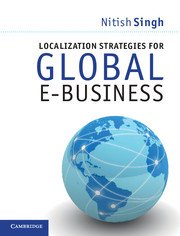Book contents
- Frontmatter
- Contents
- Figures
- Tables
- Preface
- Illustration credits and acknowledgements
- 1 Global e-commerce opportunities and challenges
- 2 International e-business expansion and market entry strategies
- 3 Global online consumer segmentation
- 4 Web globalization strategies
- 5 Developing international websites: internationalization
- 6 Effectively localizing international websites
- 7 Managing a web globalization value chain
- 8 Optimizing international websites
- 9 Assessing web globalization efforts
- 10 Strategic industry insights and emerging localization trends
- Web globalization resources
- Index
- References
5 - Developing international websites: internationalization
Published online by Cambridge University Press: 05 June 2012
- Frontmatter
- Contents
- Figures
- Tables
- Preface
- Illustration credits and acknowledgements
- 1 Global e-commerce opportunities and challenges
- 2 International e-business expansion and market entry strategies
- 3 Global online consumer segmentation
- 4 Web globalization strategies
- 5 Developing international websites: internationalization
- 6 Effectively localizing international websites
- 7 Managing a web globalization value chain
- 8 Optimizing international websites
- 9 Assessing web globalization efforts
- 10 Strategic industry insights and emerging localization trends
- Web globalization resources
- Index
- References
Summary
Developing international websites
Developing international websites without a well-laid-out plan can make the web globalization process disruptive, complex, and expensive. If a company lacks a systematic policy for its international web development and instead creates international sites only as needed, a number of problems can arise.
Brand inconsistency Creating international sites on an ad hoc basis makes it difficult to maintain a consistent brand identity and at the same time meet locale-specific requirements. Replicating past efforts and ensuring that past standards are met adds to the project’s time, coordination tasks, and cost.
Technical difficulties Adapting program code and modifying user interface elements and customer input fields (e.g., if the format for addresses, time, and date differs in different locations) is more difficult and less efficient if a company lacks an organization-wide process to ensure a modular website design or if back-end processes are inflexible or incapable of being leveraged across multiple locales.
Functional difficulties Without a proper plan for developing international sites, companies can run into issues such as how to depict and support various languages and writing systems on their websites, how to account for the text expansion and contraction that results from translating from one language to another, how to account for bidirectional text, etc.
[…]
- Type
- Chapter
- Information
- Localization Strategies for Global E-Business , pp. 119 - 147Publisher: Cambridge University PressPrint publication year: 2011



